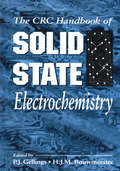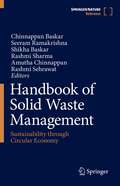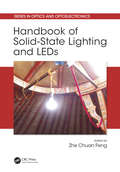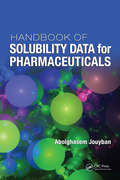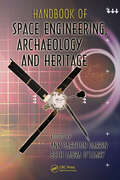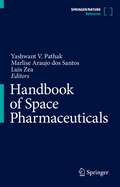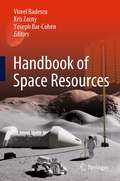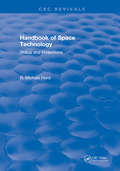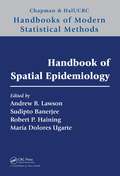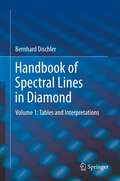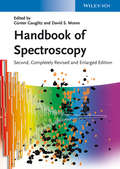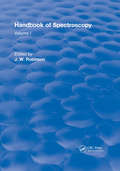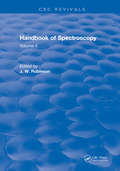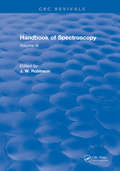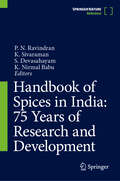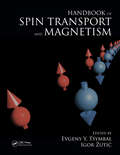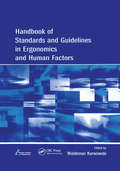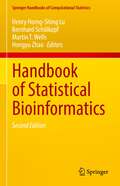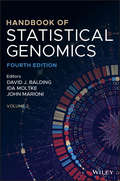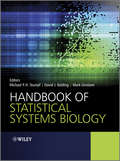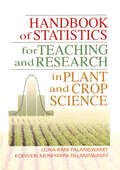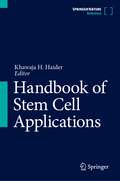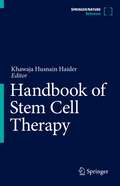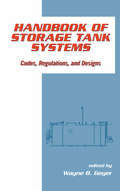- Table View
- List View
Handbook of Solid State Electrochemistry
by P. J. GellingsThe Handbook of Solid State Electrochemistry is a one-stop resource treating the two main areas of solid state electrochemistry: electrochemical properties of solids such as oxides, halides, and cation conductors; and electrochemical kinetics and mechanisms of reactions occurring on solid electrolytes, including gas-phase electrocatalysis. The fund
Handbook of Solid Waste Management: Sustainability through Circular Economy
by Seeram Ramakrishna Shikha Baskar Chinnappan Baskar Rashmi Sharma Amutha Chinnappan Rashmi SehrawatThe issue and finding the green solution of Solid Waste Management are important challenges throughout the world. This book explores cutting edge developments in Circular Economy and Sustainability on Solid Waste Management, current research perspectives, existing problems on solid waste management system, industrial development and the latest green methodology for in Solid Waste conversion and regenerate products and materials, environmental solutions, social awareness and development on solid waste management and the future perspectives of Circular Economy for industrial revolution 4.0 with the mission of green chemistry and engineering on solid waste management. It focuses on chapters from different researchers, faculty members, scientists and engineers, industrialist and experts from different countries working on the Circular Economy on Solid Waste Management. It also features the importance of integration of multi-disciplinary research fields on Circular Economy for Sustainable Development. It provides latest development in and current research perspectives, technology development, and critical thinking and societal requirements and development on Circular Economy of Solid Waste Management to researchers, scientists, engineers, environmental managers, policy makers, and Experts of Energy Division of Government and Private Organization and Industries.^
Handbook of Solid-State Lighting and LEDs
by Zhe Chuan FengThis handbook addresses the development of energy-efficient, environmentally friendly solid-state light sources, in particular semiconductor light emitting diodes (LEDs) and other solid-state lighting devices. It reflects the vast growth of this field and impacts in diverse industries, from lighting to communications, biotechnology, imaging, and medicine. The chapters include coverage of nanoscale processing, fabrication of LEDs, light diodes, photodetectors and nanodevices, characterization techniques, application, and recent advances. Readers will obtain an understanding of the key properties of solid-state lighting and LED devices, an overview of current technologies, and appreciation for the challenges remaining. The handbook will be useful to material growers and evaluators, device design and processing engineers, newcomers, students, and professionals in the field.
Handbook of Solubility Data for Pharmaceuticals
by Abolghasem JouybanAqueous solubility is one of the major challenges in the early stages of drug discovery. One of the most common and effective methods for enhancing solubility is the addition of an organic solvent to the aqueous solution. Along with an introduction to cosolvency models, the Handbook of Solubility Data for Pharmaceuticals provides an extensive datab
Handbook of Space Engineering, Archaeology, and Heritage (Advances in Engineering Series)
by Beth Laura O’Leary Ann Garrison DarrinSome might think that the 27 thousand tons of material launched by earthlings into outer space is nothing more than floating piles of debris. However, when looking at these artifacts through the eyes of historians and anthropologists, instead of celestial pollution, they are seen as links to human history and heritage.Space: The New Frontier for Ar
Handbook of Space Pharmaceuticals
by Yashwant V. Pathak Marlise Araujo dos Santos Luis ZeaThis handbook, directed at medical professionals and students who are involved in developing the space industry or are academicians doing research in this area, covers current pharmaceutical knowledge about the difference in medication efficacy in space versus on Earth and includes trial results and best practices for the space research and travel industry. The well-known contributors come from an interdisciplinary background and address all aspects of the subject, from the physiological impact of spaceflight to the effects of radiation.As the commercial space industry expands its operations in industry and tourism, the field of space pharmaceuticals is growing commensurately. Existing pharmacological research from space is thoroughly covered in this book, and Earth applications are also described. Potential pharmacological solutions are posed along with the known challenges and examples from existing studies, which are detailed at length. This major reference work is a comprehensive and important medical resource for all space industry players.
Handbook of Space Resources
by Yoseph Bar-Cohen Viorel Badescu Kris ZacnyEarth has limited material and energy resources, while these resources are virtually unlimited in space. It is only a matter of time, before planetary resources are mined and used in-situ to sustain human and robotic exploration or returned to Earth for commercial gain. This book covers a number of aspects related to space resources. In particular, subjects related to mission concepts, exploration approaches, mining and extraction technologies, commercial potential, and regulatory aspects of space resources are covered in detail. This book is therefore a good resource for readers who seek background and deeper understanding of space resources related activities.
Handbook of Space Technology: Status and Projections
by R. Michael HordThis book presents current and anticipated quantitative values for a wide range of cirtical figures of merit which characterize technological capabilities in the major discipline areas of space technology. The projections are based on historical data and the considered opinions of knowledgable experts in government and industry who are active contributors in their respective fields.
Handbook of Spatial Epidemiology (Chapman & Hall/CRC Handbooks of Modern Statistical Methods)
by Andrew B. Lawson María Dolores Ugarte Sudipto Banerjee Robert P. HainingHandbook of Spatial Epidemiology explains how to model epidemiological problems and improve inference about disease etiology from a geographical perspective. Top epidemiologists, geographers, and statisticians share interdisciplinary viewpoints on analyzing spatial data and space-time variations in disease incidences. These analyses can provide imp
Handbook of Spectral Lines in Diamond
by Bernhard DischlerThis handbook is a breakthrough in the understanding of the large number of spectral lines in diamond. Data on more than 2000 lines and bands are presented in 200 tables, including many unpublished results. With a novel organization scheme, the search for a specific line is greatly simplified as a benefit for researchers and students. In order to meet the interest in the understanding of the spectra, structure assignments for 80 % of the lines are given, of which 15 % only were published before. The majority of the structures for the 300 centers is explained in most cases for the first time. A key instrument in the interpretation is the analysis by donor-acceptor pair transitions. In a special chapter 95 such centers are listed and discussed, of which only two have been published before, the first one by the present author in 1994.
Handbook of Spectroscopy, 4 Volume Set
by David S. Moore Günter GauglitzThis second, thoroughly revised, updated and enlarged edition provides a straightforward introduction to spectroscopy, showing what it can do and how it does it, together with a clear, integrated and objective account of the wealth of information that may be derived from spectra. It also features new chapters on spectroscopy in nano-dimensions, nano-optics, and polymer analysis.Clearly structured into sixteen sections, the Handbook of Spectroscopy, 2nd, Completely Revised and Enlarged Edition, 4 Volume Set covers everything from spectroscopy in nanodimensions to medicinal applications, spanning a wide range of the electromagnetic spectrum and the physical processes involved, from nuclear phenomena to molecular rotation processes.In addition, data tables provide a comparison of different methods in a standardized form, allowing readers to save valuable time in the decision process by avoiding wrong turns, and also help in selecting the instrumentation and performing the experiments. These four volumes are a must-have companion for daily use in every lab.View sample pdf chapters:Front Matter http://onlinelibrary.wiley.com/doi/10.1002/9783527654703.fmatter/pdfPreparation of Liquid and Solid Samples http://onlinelibrary.wiley.com/doi/10.1002/9783527654703.ch1/pdfMethods: Optical Spectroscopy http://onlinelibrary.wiley.com/doi/10.1002/9783527654703.part2/pdfMethods: NMR http://onlinelibrary.wiley.com/doi/10.1002/9783527654703.part3/pdfMethods: Surface Analysis http://onlinelibrary.wiley.com/doi/10.1002/9783527654703.part6/pdfApplications: Process Control http://onlinelibrary.wiley.com/doi/10.1002/9783527654703.part11/pdfIndex http://onlinelibrary.wiley.com/doi/10.1002/9783527654703.index/pdfTake advantage of the introductory offer!Introductory price, valid until 31 July 2014: $675.00 / £410.00 / 499.00Thereafter: $740.00 / £450.00 / 549.00
Handbook of Spectroscopy: Volume I
by J. W. RobinsonThe principle objective of this handbook is to provide a readily accessible source of information on the major fields of spectroscopy. Specifically, these fields are NMR, IR, Raman, UV (absorption and fluorescence), ESCA, X-Ray (absorption diffraction fluorescence), mass spectrometry, atomic absorption, flame photometry, emission spectrography, and flame spectroscopy. It will be of particular use to analytical, organic, inorganic chemists or spectroscopists wishing to identify materials or compounds. The book will indicate to them which techniques may provide useful information and what kind of information will and will not be provided. In short, it will be a companion to those spectroscopists who have need to broaden their horizons into the major fields discussed.
Handbook of Spectroscopy: Volume II
by J. W. RobinsonThe principle objective of this handbook is to provide a readily accessible source of information on the major fields of spectroscopy. Specifically, these fields are NMR, IR, Raman, UV (absorption and fluorescence), ESCA, X-Ray (absorption diffraction fluorescence), mass spectrometry, atomic absorption, flame photometry, emission spectrography, and flame spectroscopy. It will be of particular use to analytical, organic, inorganic chemists or spectroscopists wishing to identify materials or compounds. The book will indicate to them which techniques may provide useful information and what kind of information will and will not be provided. In short, it will be a companion to those spectroscopists who have need to broaden their horizons into the major fields discussed.
Handbook of Spectroscopy: Volume III
by J. W. RobinsonThe principle objective of this handbook is to provide a readily accessible source of information on the major fields of spectroscopy. Specifically, these fields are NMR, IR, Raman, UV (absorption and fluorescence), ESCA, X-Ray (absorption diffraction fluorescence), mass spectrometry, atomic absorption, flame photometry, emission spectrography, and flame spectroscopy. It will be of particular use to analytical, organic, inorganic chemists or spectroscopists wishing to identify materials or compounds. The book will indicate to them which techniques may provide useful information and what kind of information will and will not be provided. In short, it will be a companion to those spectroscopists who have need to broaden their horizons into the major fields discussed.
Handbook of Spices in India: 75 Years of Research and Development
by P. N. Ravindran K. Nirmal Babu K. Sivaraman S. DevasahayamThis compendium presents comprehensive information on more than 25 important spice crops commercially grown in India and traded globally, apart from over 40 spices that have the potential to be popularized. In 70 chapters the book covers the achievements in research and development made in India for the past 75 years in various organizations including research institutes, agricultural universities and private sector laboratories. Spices are natural products of plant origin, used primarily for flavouring and seasoning or for adding pungency and flavour to foods and beverages. The flavour and fragrance of Indian spices had a magic spell on human culture since very ancient days. The importance of spices in Indian life and its contribution to the economy are substantial. India, as the world’s leading producer of spices is also a significant stakeholder in spices export trade globally. Indian spices being sources of many high value compounds, are also gaining muchimportance for other diversified uses especially for their pharmaceutical and nutraceutical properties. A wide variety of 52 spices are grown in India including black pepper, chillies, cardamom, ginger, turmeric, cinnamon, nutmeg, garlic, onion, cumin, coriander, saffron and vanilla. This book complies a comprehensive, holistic review on the subject, written by the best experts in the field in India representing diverse agencies. This book is a single point reference book for all those involved in the research, study, teaching and use of spices in India and abroad.
Handbook of Spin Transport and Magnetism
by Evgeny Y. Tsymbal Igor ŽutićIn the past several decades, the research on spin transport and magnetism has led to remarkable scientific and technological breakthroughs, including Albert Fert and Peter Grunberg's Nobel Prize-winning discovery of giant magnetoresistance (GMR) in magnetic metallic multilayers. Handbook of Spin Transport and Magnetism provides a comprehensive, bal
Handbook of Standards and Guidelines in Ergonomics and Human Factors
by Waldema KarwowskiA comprehensive review of international and national standards and guidelines, this handbook consists of 32 chapters divided into nine sections that cover standardization efforts, anthropometry and working postures, designing manual material, human-computer interaction, occupational health and safety, legal protection, military human factor standar
Handbook of Statistical Bioinformatics (Springer Handbooks of Computational Statistics)
by Bernhard Schölkopf Henry Horng-Shing Lu Hongyu Zhao Martin T. WellsNow in its second edition, this handbook collects authoritative contributions on modern methods and tools in statistical bioinformatics with a focus on the interface between computational statistics and cutting-edge developments in computational biology. The three parts of the book cover statistical methods for single-cell analysis, network analysis, and systems biology, with contributions by leading experts addressing key topics in probabilistic and statistical modeling and the analysis of massive data sets generated by modern biotechnology. This handbook will serve as a useful reference source for students, researchers and practitioners in statistics, computer science and biological and biomedical research, who are interested in the latest developments in computational statistics as applied to computational biology.
Handbook of Statistical Genomics
by David J. Balding Ida Moltke John MarioniA timely update of a highly popular handbook on statistical genomics This new, two-volume edition of a classic text provides a thorough introduction to statistical genomics, a vital resource for advanced graduate students, early-career researchers and new entrants to the field. It introduces new and updated information on developments that have occurred since the 3rd edition. Widely regarded as the reference work in the field, it features new chapters focusing on statistical aspects of data generated by new sequencing technologies, including sequence-based functional assays. It expands on previous coverage of the many processes between genotype and phenotype, including gene expression and epigenetics, as well as metabolomics. It also examines population genetics and evolutionary models and inference, with new chapters on the multi-species coalescent, admixture and ancient DNA, as well as genetic association studies including causal analyses and variant interpretation. The Handbook of Statistical Genomics focuses on explaining the main ideas, analysis methods and algorithms, citing key recent and historic literature for further details and references. It also includes a glossary of terms, acronyms and abbreviations, and features extensive cross-referencing between chapters, tying the different areas together. With heavy use of up-to-date examples and references to web-based resources, this continues to be a must-have reference in a vital area of research. Provides much-needed, timely coverage of new developments in this expanding area of study Numerous, brand new chapters, for example covering bacterial genomics, microbiome and metagenomics Detailed coverage of application areas, with chapters on plant breeding, conservation and forensic genetics Extensive coverage of human genetic epidemiology, including ethical aspects Edited by one of the leading experts in the field along with rising stars as his co-editors Chapter authors are world-renowned experts in the field, and newly emerging leaders. The Handbook of Statistical Genomics is an excellent introductory text for advanced graduate students and early-career researchers involved in statistical genetics.
Handbook of Statistical Systems Biology
by Michael Stumpf David J. Balding Mark GirolamiSystems Biology is now entering a mature phase in which the key issues are characterising uncertainty and stochastic effects in mathematical models of biological systems. The area is moving towards a full statistical analysis and probabilistic reasoning over the inferences that can be made from mathematical models. This handbook presents a comprehensive guide to the discipline for practitioners and educators, in providing a full and detailed treatment of these important and emerging subjects. Leading experts in systems biology and statistics have come together to provide insight in to the major ideas in the field, and in particular methods of specifying and fitting models, and estimating the unknown parameters.This book:Provides a comprehensive account of inference techniques in systems biology.Introduces classical and Bayesian statistical methods for complex systems.Explores networks and graphical modeling as well as a wide range of statistical models for dynamical systems.Discusses various applications for statistical systems biology, such as gene regulation and signal transduction.Features statistical data analysis on numerous technologies, including metabolic and transcriptomic technologies.Presents an in-depth presentation of reverse engineering approaches.Provides colour illustrations to explain key concepts.This handbook will be a key resource for researchers practising systems biology, and those requiring a comprehensive overview of this important field.
Handbook of Statistics for Teaching and Research in Plant and Crop Science
by Usha PalaniswamyMore than a textbookit’s also a valuable reference book for researchers and crop science professionals!The Handbook of Statistics for Teaching and Research in Plant and Crop Science presents the fundamental concepts of important statistical methods and experimental designs to the students and researchers who need to apply t
Handbook of Stem Cell Applications
by Khawaja H. HaiderThis handbook reviews the clinical applications of stem cell-based therapy. The book covers the clinical applications of stem cells in cardiovascular diseases, neurological and ocular diseases, pediatrics, and the role of cancer stem cell-derived exosomal microRNA payload in lung cancer. The chapter reviews emerging stem cell therapy and tissue engineering approaches in neurodegenerative diseases. The book further examines the applications of stem cells in various fields of dentistry, and for the regeneration of oral and non-oral tissues. The chapters also explore the application of 3D bioprinting in conjunction with bone marrow mesenchymal stem cells for the treatment of bone defects and state-of-the-art technology for bone and cartilage regeneration using mesenchymal stem cells. The book presents stem cell-based therapy against renal, pancreatic, and kidney diseases and examines the advantages of a novel hepatic stem for cirrhotic liver repair and regeneration. Lastly, the book provides methodological and procedural advancements in stem cell-based therapy, including the applications of single-cell sequencing in stem cell research. This handbook is a major one-stop reference for researchers working in regenerative medicine, cellular pharmacology, stem cell research in general, and those involved in specific areas of adult stem cells as well as embryonic and induced pluripotent stem cells.
Handbook of Stem Cell Therapy
by Khawaja Husnain HaiderThe handbook comprehensively reviews the therapeutic potential of stem cells and stem cell secretome-based cell-free strategies in regenerative medicine. The chapters in section I and section II respectively discuss the diverse applications of mesenchymal stem cells and non- mesenchymal stem cells, including skeletal myoblasts, endothelial progenitor cells, adipose tissue-derived stem cells, induced pluripotent stem cells, and neuronal stem cells in myocardial repair, inflammatory bowel disease, cognitive deficits, wound healing, retinal disorders, and COVID-19. The subsequent chapters in section IIIprimarily focused on the fast-emerging cell-free therapy approach in regenerative medicine for tissue repair and regeneration. These chapters review the impact of stem cell-derived secretome on various biological processes such as angiogenesis, neurogenesis, tissue repair, immunomodulation, musculoskeletal pathologies, wound healing, anti-fibrotic, and anti-tumorigenesis for tissue maintenance and regeneration.Lastly, section IV summarizes miscellaneous aspects of cell-based therapy, includingthe treatment advantages, opportunities, and shortcomings in stem cell-based therapy, potentially helping to refine future studies and translate them from experimental to clinical studies. Moreover, this section also has chapters on cancer stem cells as novel targets in cancer therapeutics. This Major Reference Book (MRW) is a valuable resource for researchers involved in stem cell research to understand the multifaceted therapeutic applications of stem cells and their derivative secretome in regenerative medicine.
Handbook of Storage Tank Systems: Codes: Regulations, and Designs
by Wayne B. GeyerThis timely reference surveys manufacturing and installation methods, standards, and specifications of factory-made steel storage tanks and appurtenances for petroleum, chemicals, hydrocarbons, and other flammable or combustible liquids. It chronicles the trends toward secondary containment, aboveground storage tanks, and corrosion-resistant underground steel storage systems. Written by over 20 leading experts in industry, this handbook discusses relevant fire safety and building codes, construction specifications, and environmental regulations, making it a valuable asset for chemical, pollution, environmental, industrial, mechanical, and civil engineers, to name only a few.
